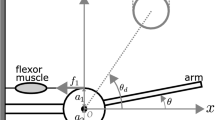Abstract.
Reaching movement is a fast movement towards a given target. The main characteristics of such a movement are straight path and a bell-shaped speed profile. In this work a mathematical model for the control of the human arm during ballistic reaching movements is presented. The model of the arm contains a 2 degrees of freedom planar manipulator, and a Hill-type, non-linear mechanical model of six muscles. The arm model is taken from the literature with minor changes. The nervous system is modeled as an adjustable pattern generator that creates the control signals to the muscles. The control signals in this model are rectangular pulses activated at various amplitudes and timings, that are determined according to the given target. These amplitudes and timings are the parameters that should be related to each target and initial conditions in the workspace. The model of the nervous system consists of an artificial neural net that maps any given target to the parameter space of the pattern generator. In order to train this net, the nervous system model includes a sensitivity model that transforms the error from the arm end-point coordinates to the parameter coordinates. The error is assessed only at the termination of the movement from knowledge of the results.
The role of the non-linearity in the muscle model and the performance of the learning scheme are analysed, illustrated in simulations and discussed. The results of the present study demonstrate the central nervous system’s (CNS) ability to generate typical reaching movements with a simple feedforward controller that controls only the timing and amplitude of rectangular excitation pulses to the muscles and adjusts these parameters based on knowledge of the results. In this scheme, which is based on the adjustment of only a few parameters instead of the whole trajectory, the dimension of the control problem is reduced significantly. It is shown that the non-linear properties of the muscles are essential to achieve this simple control. This conclusion agrees with the general concept that motor control is the result of an interaction between the nervous system and the musculoskeletal dynamics.
Similar content being viewed by others
Author information
Authors and Affiliations
Additional information
Received : 21 May 1996 / Accepted in revised form : 10 June 1997
Rights and permissions
About this article
Cite this article
Karniel, A., Inbar, G. A model for learning human reaching movements. Biol Cybern 77, 173–183 (1997). https://doi.org/10.1007/s004220050378
Issue Date:
DOI: https://doi.org/10.1007/s004220050378




